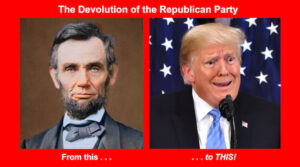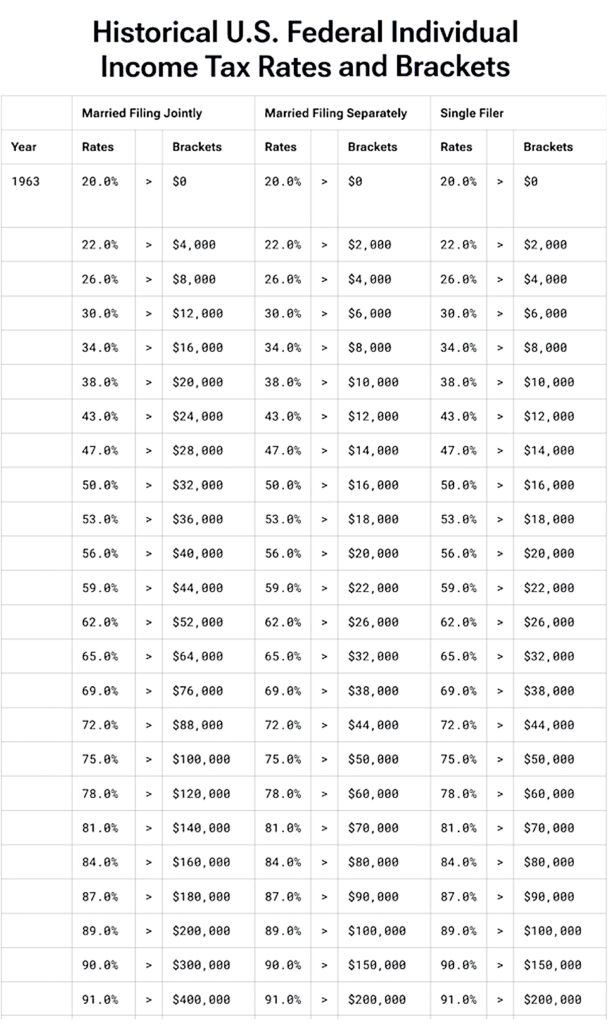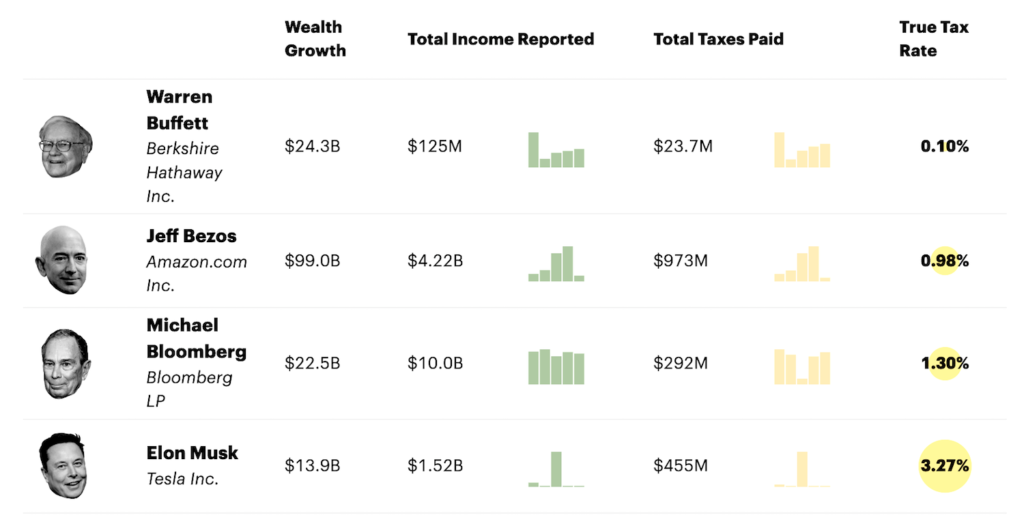 If we’re going to divide the voting public into two warring tribes, we should understand what allegiance to each of the major parties actually represents. Here we look at the ‘R’, next the ‘D’.
If we’re going to divide the voting public into two warring tribes, we should understand what allegiance to each of the major parties actually represents. Here we look at the ‘R’, next the ‘D’.
History adds clarity and perspective.
Here is the U.S. Federal Income Tax Rate Schedule from 1963.
Back then, if your gross income was $4,000 or less, you paid a 20% rate. If your gross income was $400,000 or more, on the earnings over $400,000 you paid a 91% rate. This scaling of tax liability is based on a straightforward, if highly contentious principle. The more you earn, the larger portion of those earnings should go toward the general funding of government and greater good of society. What is tendered in taxes is apportioned by ability to pay.
Granted, the above chart represents an extreme example of progressive taxation in our history. But it was very typical for almost two decades. The 91% rate was in effect 1946-1951 and 1954-1963. It was only exceeded at the end of WWII, 1944-1945 (94%) and two years in the 50s, 1952-1953 (92%).
Obviously, this inspired a lot of odium among the wealthy. They claimed such a contrivance is intrinsically flawed. Because we are all just individuals, one person equal to every other in the eyes of God, we all should receive equal treatment. Just because some individuals are cleverer or financially better off than others should not single them out to be penalized or punished. Conservatives insist that tax rates should therefore be regressive – no fancy formulas and sliding scales – as opposed to progressive. We currently have a progressive tax schedule, though not as drastic as in 1944-1963. The range is 10% to a maximum of 37%.
The most radically regressive counter to progressive taxation schedules proposed by extreme conservatives is the flat tax. We merely calculate how much money is needed and based on that, derive a single percentage, a tax rate applied across the board equally to everyone.
While it is elegantly simple and seems to smack of common sense, let’s do a simple thought experiment to see how it would play out in the real world.
For our example, let’s use a fairly modest flat tax rate of 30%.
Current HHS Poverty Guidelines state that for the 48 contiguous states and District of Columbia, the poverty threshold for a family of four is $30,000. Such a family unit would be required to pay $9,000 in federal taxes, leaving them $21,000 to cover all family living expenses for the year. That would be housing, food, transportation, clothing, utilities, health care, etc. All the necessities for basic subsistence for four people on $21,000. The brutal truth is they would be confronted with a choice between eating and having a roof over their heads. The average rent for the 48 contiguous states and District of Columbia is $1,095 per month. There goes $13,140 for the year. That leaves $5.38 per day to feed each member of the family. I guess if they ate dog food, they could survive. Of course, there would be no money for anything else.
Mind you, the figures just quoted are regarded by many credible COL sites as ridiculously conservative. One says a family of four needs $70,784 to survive. Another one puts it at $92,989, more than three times the poverty line figure we used as an example.
Moving on.
Jeff Bezos’ “annual earnings” is hard to nail down. It’s definitely a lot of money and one site claims it’s $64 billion. At the same time, he sometimes manages to pay little or no taxes. Considering how convoluted his personal finances are, capturing what his “taxable income” might be is like trying to grab grasshoppers in a field at night, blindfolded, using tweezers. For our purposes here, we’ll say the 30% flat tax applies to the whole $64 billion, which comes to $19,200,000,000. Brace yourselves and get out the tissues. I’m fighting my own tears as I report this. This means poor Mr. Bezos would be forced to eke out something resembling a decent life for the year on a mere $44,800,000,000. Of course, if he came up short, he could tap into his $161 billion of personal wealth. You know, to make the credit card payments on time and keep gas in the tank. Incidentally, as an aside, spending a million dollars a day, it would take over 440 years to spend Bezos’ fortune. How long would it take that family of four to go through the after-flat tax $21,000? Three months?
The obvious point is that debates on political philosophy are non-starters in the real world. Arguing over whether Jeff Bezos deserves to be so rich or not, or whether the Ten Commandments of neoliberal capitalism demand that the ultra-wealthy be handled with kid gloves when it comes to paying taxes, whether grotesque levels of wealth inequality are acceptable, is simply absurd. None of this plays in the real world. We have a country to run and lives to live. We have a nation to cohere and a large complex, highly diverse society to manage and nurture. Divided we fall. Fragmented we fail. The greater good may require the lesser good to be dragged kicking and screaming to embrace compromises which have the greater consensus. Who was it who said “democracy is messy”? The divine right of kings didn’t survive modern societal evolution. What place does the divine right of the rich have in a modern functioning democratic nation? I’m not being facetious. Do we have to enforce sensible, constructive tax policy with a guillotine?
By the way, there’s method to my madness here.
I’m focusing here on tax policy and its real-world outcomes, because I think that’s the perfect vehicle for contrasting our nation’s two major political religions: liberal vs. conservative. While recent dramatic shifts on a host of specific issues have caused some confusion as to what these terms precisely mean, they’re still useful in identifying the two main political tribes in the U.S. As they too often say, follow the money. The antithetical ways conservatives and liberals approach tax policy pretty much sums up their respective views on the proper relationship between government and the governed.
Having said that, I have no intention of attempting to arbitrate the opposing dogmas of sociopathic conservatism and bleeding-heart liberalism. Each is supported by meticulously cherry-picked facts and impeccable illogic. The simple, straightforward truth is that since these antagonistic positions are generated by completely different, totally incompatible premises and mutually exclusive world views, they inevitably arrive at very different places. There is no way to resolve the differences. However, as I hope you’ll discover by the end of this book, that is not to suggest that we as a society must remain mired in confrontation and paralyzed by gridlock.
Back to reality.
I’ve been citing “official” numbers in terms of what people are supposed to contribute in taxes. The vast majority of everyday citizens play by the book. The wealthy, despite their sanctimonious virtue signaling and interminable whining about onerous tax burdens, do not.
With armies of tax consultants and tax code attorneys at their disposal, the rich don’t pay anything close to the official rate. Just look at these four paragons of the neoliberal profit-over-people paradigm.
The agenda of the super-wealthy is not at all opaque or complicated. They want to keep as much money as they can by paying as little in taxes as possible. This dramatically and negatively impacts all of us. To keep their overall tax burden down, they aggressively cut spending. The list is chilling: Medicare for veterans; funding for schools with low-income students and students with disabilities; funding for pre-school and child care; meager allocations for WIC, i.e. nutrition assistance for women, infants and children; funding for Meals on Wheels which provides nutrition services for seniors; housing choice vouchers for seniors and veterans; funding for NIH, which means delays in cancer and Alzheimer’s research. Still high on the Republican agenda is the longstanding goal of cutting Social Security and Medicare.
Taking a sledgehammer to initiatives which offer comfort, relief and support, often to the most vulnerable and disadvantaged, appears to liberals as cruel, selfish, inhumane, unconscionable, vicious and diabolically insensitive. Yet – and it pains me to say this – it’s important to acknowledge that for conservatives, it’s none of the above. For them it’s merely being prudent and responsible, only paying for what we can afford. They insist we simply don’t have the money to take care of everyone in need. Of course, conservatives install a big, fat monkey wrench in the machinery. Relentlessly insisting on tax decreases guarantees we are always short on money. And the con doesn’t stop there. Their relentless calls to cut taxes is then given further justification. We’re told that letting the “job creators” keep more of their personal wealth and corporate profits is great for the economy. And a thriving economy eliminates the need for all those expensive social programs. Thus, the less the wealthy pay in taxes, the better off we all are. So the argument goes.
Quite a web of magical thinking being floated, for sure.
At the same time, it is powerful, persuasive magical thinking, propagated by well-funded think tanks, promoted by influential economists, reinforced constantly by toadying pundits and the wholly captured media. Understand, this assault on the common good has been underway for over five decades. The focus and hard work of this blitz shows. The wealthy have perfected their game, while the defenders of us everyday citizens have been left scrambling, often bickering among themselves like alley cats, thrown into disarray by getting pointlessly sidetracked – identity politics, though valid and important, is a perfect example of such squandering of energy and time – thus rendered incapable of formulating and agreeing on a coherent alternative vision, based on fairness and respect for the general welfare and common good. Or as with the Democratic Party, would-be reformers have simply been bought out.
We need a fresh start. We need to look at our situation with fresh eyes.
This is where the candidacy of Robert F. Kennedy Jr. came in. He was asking the right questions, the tough questions, the necessary questions.
What kind of country do we want to live in and what do we need to do to make that happen? In a true democracy, the ‘we’ runs the show. Everyone has to give, as well as take. Everyone has to make sacrifices. Everyone has to think in terms of the “everyone”.
Timeless inspiration helps.
“Ask not what your country can do for you. Ask what you can do for your country.” – John F. Kennedy, 01/20/61
This is a very tall order, both profound and fragile. Yet, it sounds as fresh and relevant today as it did sixty plus years ago when it was first spoken.
Though the election is behind us and Kennedy was forced to join the ranks of Donald Trump, we are still presented with the opportunity to meet that challenge.
RFK Jr’s message couldn’t be more timely or critical for our future. The posturing by both major parties is a deadly pas de deux that’s impoverishing everyday citizens, vanquishing the middle class, destroying the American dream, and further bloating the vast fortunes of the wdes – Republicans and Democrats – in a call for unity and a promise of hope. ealthy. It’s easy to blame just the Republicans for this, but Mr. Kennedy consistently reached out to both sides – Republicans and Democrats – in a call for unity and a promise of hope. [See “An Epistle to Robert F. Kennedy, Jr.— DV ed]
I only hope his enemies – the enemies of “the people” – are paralyzed and incapable of torpedoing what may be our last chance to save America. Time is not on our side.
R is for regressive.
R is for rapacious.
R is for ruthless.
This content originally appeared on Dissident Voice and was authored by John Rachel.

